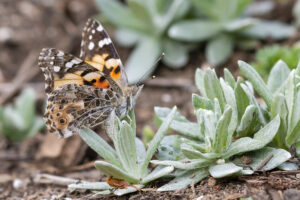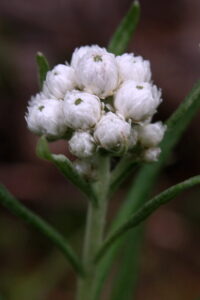Plant Profile: Sunshine brings pearly everlasting
Every summer, people from all around the Pacific Northwest travel to Washington to take in the millions of native wildflowers growing along the Columbia River. Many do not know how easy it is to replicate a native wildflower meadow in their own backyard, or even in a window box!
Wildflowers are great for pollinators, and many provide various medicinal uses. Delridge Neighborhoods Development Association’s (DNDA) Nature team brings you more information about pearly everlasting, just one example of our hundreds of native wildflower species in Washington.
The Wildflower
Pearly everlasting — also known as western pearly everlasting — is an herbaceous perennial wildflower with white and yellow petals. The scientific name for the flower is Anaphalis margaritacea.
As part of the sunflower family (Asteraceae), one of pearly everlasting’s key characteristics is its modified leaves, or bracts, which surround the more tubular disk of flowers that make up the flower head.
The plant blooms between June and October, and it flourishes in dry woods with sun or partial shade in gravelly soil. You can find them in our local parks, like Roxhill Park on SW Roxbury Street.
The genus Anaphalis — collectively referred to as “everlastings” — contains more than 100 species, the majority of which are found in India, South Asia, and Europe. Western pearly everlasting is the only common species native to North America.
Pearly everlasting is also a popular pollinator plant, attracting American lady butterflies, painted lady butterflies, sweat bees, and more.
Leaves and Stem
The leaves of pearly everlasting are long and slender with a gray-green to white color. They also have white, woolly undersides, matching the stems. The leaf blades are one-to-three-veined and are 3-10 centimeters long, with edges that curl under.
Pearly everlasting can grow up to three feet tall. It has a whitish-green, dense, woolly stem, and it often grows in clumps, creating a bushy appearance.
Blossom
Pearly everlasting’s blossoms are globular and white, surrounding a yellow center. The white bracts form a spherical or pearl-shaped structure — from which its common name originates — around the yellow disk flowers.
The bracts continue to appear fresh long after the central yellow flowers have wilted, making them a popular choice for dried flower arrangements.
Medicinal Uses
Indigenous peoples traditionally use odoriferous plants like pearly everlasting for various medicinal purposes. The entire plant can be used as an anodyne — or painkiller — as well as an antiseptic, astringent, expectorant, and sedative. A poultice, or a soft mass of the flower, can be applied to burns, sores, and joints for pain relief.
An infusion of the plant can also be steamed and inhaled to treat headaches and colds. If you are interested in the medicinal uses of pearly everlasting and other native plants, remember to consult a healthcare professional.
Grow Pearly Everlasting at Home
You can grow pearly everlasting, or other native wildflowers, in a container at home! Any container that will hold soil will work as long as it has drainage holes on the bottom. Fill the container with a lightweight, porous planting soil and mix it with compost. This will give the wildflowers plenty of nutrients to support them as they grow from seeds.
Look for a native wildflower seed mix, or pearly everlasting seeds, at your local nursery, and follow the planting instructions included. Before you know it, you’ll have a small wildflower garden right outside your window.
— Written by DNDA Environmental Engagement Specialist Louisa Keyani



